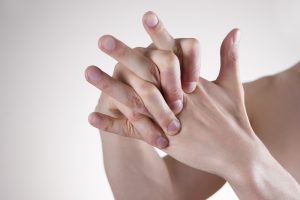All you need to know about arthritis of the MCP joint in the finger (knuckle joint)
The hand is the most important tool to perform motor operations. That can be something simple like turning the page of a magazine. We can also perform extremely complex tasks with our hands, such as pulling a thread through the eye of a needle. The hand is therefore a delicately structured organ with a large number of muscles, bones and joints. We call the major joints at the base of fingers the Meta Carpal Phalangeal (MCP) joints or knuckle joints. Here, as in all other joints of the body, arthritis can develop.
What is the function of the MCP joint?
This is the joint between the metacarpals and the first phalange of the finger. It will be clearly visible when you make a fist. The knuckles are then clearly visible. It is a hinge joint with a very complex structure. The MCP joint makes it possible to perform the various operations, such as grabbing, holding and squeezing. The MCP joints of the fingers can only bend and stretch. The thumb is equipped with a so-called saddle joint, enabling the thumb to move in multiple directions.
How does osteoarthritis develop in the MCP joint?
Osteoarthritis usually occurs in the knuckle joints of the thumb, index finger and middle finger. In this condition, the cartilage lining of the MCP joints will become thinner and thinner due to wear. One of the main causes is aging. Cartilage development naturally slows later in life. As a result, this tissue crumbles. This condition can also occur if after an accident the cartilage has not recovered properly. Arthritis of the MCP joint may also be due to rheumatoid arthritis. Joint inflammation can then damage the cartilage.
What are the symptoms of osteoarthritis in the MCP joint?
When the MCP joint starts to deteriorate you will suffer from pain and stiffness of the finger, and swelling may occur. The pain is worse when you want to pick up or grab something. As the MCP cartilage deterioration increases, you will experience less mobility. Holding a cup, using cutlery or opening a lid becomes more difficult. Increase in pain and loss of strength cause these problems. The cartilage degradation creates a local inflammatory reaction, which can increase the pain. Many people with arthritis at the MCP joint notice that their fingers start to point towards the little finger.
How is arthritis of the MCP joint diagnosed?
The doctor will first ask for your medical history and ask specific questions about the nature of your symptoms. Then he will carefully examine the affected finger. Usually the doctor arranges for an X-ray to be made of your hand. He can then see if the cartilage in the MCP joint is subject to wear.
How does your doctor treat the MCP joint?
There are various treatment options. You can use a simple painkiller, like acetaminophen to combat the pain. In severe pain, your doctor will prescribe an anti-inflammatory painkiller (NSAID). These medications can cause gastrointestinal complaints. If you experience these problems, you can also choose natural inflammatory inhibitors, such as the liquid Green-lipped mussel with Bio-Curcumin and Blackcurrant leaf. A splint and adjustment of activities further lead to less stress on the affected MCP joint. This can often help to reduce the symptoms.
When will your doctor recommend surgery?
If these treatments are not successful, the doctor may suggest surgery. If the cartilage is not yet severely damaged, synovectomy can be performed. During this operation, the surgeon will remove the inflamed mucous membrane from the joint. If necessary, he will also repair tendons. In the case of advanced arthritis, your doctor may recommend arthroscopy or joint replacement. In the first case, the joint is fused. This has little effect on the function of the MCP joint in the thumb. This is different for an arthrodesis of the MCP joint in the other fingers, in which reduces mobility. The second possibility is to replace the modified MCP joint with an artificial joint. This causes the pain to disappear and the finger or thumb to become mobile.

Share this page
Tweet

Download for free the booklet ‘Moving without pain’ with a retail value of $6.75 / £4.95.
Any questions? Please feel free to contact us. Contact us.






